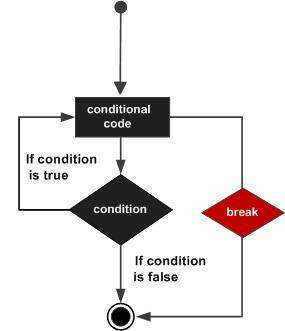The break statement in C programming language has following two usage:
- When the break statement is encountered inside a loop, the loop is immediately terminated and program control resumes at the next statement following the loop.
- It can be used to terminate a case in the switch statement (covered in the next chapter).
If you are using nested loops ( ie. one loop inside another loop), the break statement will stop the execution of the innermost loop and start executing the next line of code after the block.
Syntax:
The syntax for a break statement in C is as follows:
break;
Flow Diagram:

Example:
#include <stdio.h> int main () { /* local variable definition */ int a = 10; /* while loop execution */ while( a < 20 ) { printf("value of a: %d\n", a); a++; if( a > 15) { /* terminate the loop using break statement */ break; } } return 0; }
When the above code is compiled and executed, it produces following result:
value of a: 10 value of a: 11 value of a: 12 value of a: 13 value of a: 14 value of a: 15
No comments:
Post a Comment